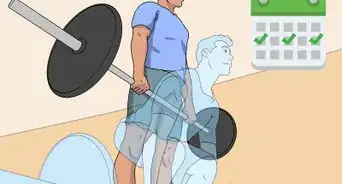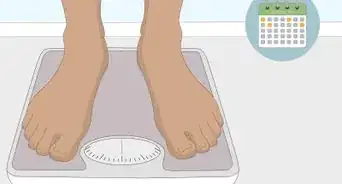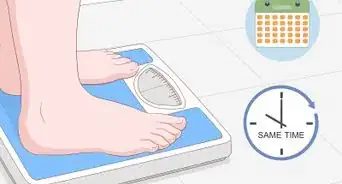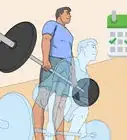This article was co-authored by Laura Flinn. Laura Flinn is a National Academy of Sports Medicine (NASM) Certified Personal Trainer, USA Olympic Weightlifting Sports Performance Coach and Certified Fitness Nutritionist, with an additional qualification as a TRX Suspension Trainer. Laura runs her own personal training program based in the San Francisco Bay Area and specializes in topics such as weight loss, muscle growth, cardiovascular training, and strength training.
There are 16 references cited in this article, which can be found at the bottom of the page.
This article has been viewed 121,593 times.
Belly fat is the fat located around the midsection of the body, and also known as "visceral fat". This is the most dangerous kind of body fat because, unlike the fat that's located just beneath the skin, belly fat affects the functioning of internal organs and is associated with a variety of negative health conditions. Postnatal women also may struggle to lose belly fat following childbirth. Making lifestyle changes in diet and exercise, together with learning more about the hazards associated with visceral fat, are the best way to lose your belly fat.
Steps
Using Diet to Lose Belly Fat
-
1Emphasize plant-based foods in your diet. Plant-based foods, including vegetables, grains, non-meat protein such as legumes and nuts, all contribute to a healthy meal plan.[1]
- Avoid short-term diets as a means to lose belly fat. Skipping meals or following fad diet plans won't be effective for long-term maintenance of a trim belly.
- Ultimately, you'll need to find a healthy diet that you can stick to.
-
2Choose lean sources of protein. If you eat meat, stick to lean meat options such as skinless chicken or turkey. Most fish is a good source of lean protein, and also includes Omega-3 fatty acids which are good for your heart. If you eat beef or pork, make sure you stick to lean cuts of meat, and keep your portions small. Trim away all visible fat.[2]
- Beans lentils, barley, seeds and nuts and other legumes are a great source of lean protein. Adding beans and peas to your soups, salads, and casseroles adds protein without adding the saturated fats that contribute to belly fat.
- Non-meat sources of protein include prepared meat-substitutes such as tofu, seitan, tempeh, veggie burgers, or tofu-dogs.
Advertisement -
3Limit your use of saturated fats. Saturated fats to avoid are found in meats and high-fat dairy products such as cheese, milk (and cream), and butter. Some plant-based oils, such as palm oil, palm kernel oil and coconut oil, also contain high levels of saturated fats. Polyunsaturated fats are a better alternative. Polyunsaturated fats are found in many nuts, seeds, avocados, and some fish.[3]
- The over-consumption of saturated fats is directly linked to increase in belly fat, as well as difficulties with insulin regulation.
- Any type of overconsumption leads to weight gain. Aim for a moderate fat intake and try to replace animal fats with plant of fish oils whenever possible.
-
4Avoid sugary foods and beverages. A thick midsection is commonly referred to as a "beer belly" for good reason! Overconsumption of sugar in the form of alcohol is a primary culprit in developing belly fat. Sugars found in processed foods, sugary sodas, energy drinks, as well as alcoholic beverages, are a common source of belly fat. To lose your belly fat, stay away from these culprits.[4]
- Drink water instead of sodas. Carbonated water can make a good substitute. Try squeezing a lemon or lime in your drink for flavor.
- Fruit juices are loaded with sugar, and don't carry the benefit of fiber that comes with eating the fruit itself. If you're trying to lose belly fat, keep your consumption of fruit juice to a minimum.
- Switch to plain, unsweetened coffee and teas. A single café mocha (medium sized) contains 11 grams of saturated fat, or 55% of the daily allotment recommended by the ADA.
-
5Pay attention to your portion sizes. Even healthy choices can become unhealthy if you're eating too much. If you're trying to lose belly fat, stick to smaller portion sizes. Try measuring your portions to make sure you're being consistent.[5]
- Be especially careful of empty extra calories such as white breads and bread products, pasta and white rice.
- Restaurants often serve large portions. Instead of cleaning your plate, get a take-away box to go.
- Eating from smaller plates and bowls allows your portions to look larger, even if they're smaller.
-
6Stay hydrated. Drinking water throughout the day may help you from feeling hungry, which will help with weight control. A glass of water before meals has been shown to help people eat less. The exact amount of water you should consume depends on your own personal chemistry. The color of your urine will show you if you're dehydrated: if it's dark, you should be drinking more water.[6]
- Water is also found in plenty of foods, particularly melons and other moist fruits.
- Flavor your water with fruits, such as watermelon, strawberry or lime. Or fill an ice tray with coconut water, freeze it, and then pop a coconut ice cube or two into your fresh water glass for some extra flavor.
-
7Eat more slowly. Eating more slowly encourages smaller portion sizes, and allows you to feel fuller faster. Because your brain takes about 20 minutes longer than your stomach to recognize that it's full, eating slowly allows you to recognize when you're full. You'll eat less, and feel more satisfied at the end of your meal.[7]
- When you eat too quickly, you don't allow the complex communication between your brain and your belly to connect, and are more likely to overeat.
- If you're trying to lose weight, simply taking more time to chew each bite, and allow your mouth to be completely empty between bites, may help.
Making Lifestyle Changes to Lose Belly Weight
-
1Spend at least 30 minutes in aerobic exercise at least 5 days per week. Moderate aerobic activity, paired with weight training to increase muscle mass, has been shown effective to reduce belly fat even if overall weight remains the same.[8] Different kinds of aerobic activity include brisk walking, running, aerobics dance classes, swimming, or hiking.
- Because you're making a lifestyle change, make sure you find an exercise program that works for you.
- Moderate exercise works best. To know if your exercise rate is moderate, see if you can talk while exercising. If you can talk, you're exercising at a moderate rate. If you can loudly sing a favorite song, you should move more quickly.
-
2Try weight lifting. Strength training, which includes weight lifting, stomach crunches, etc. builds lean muscle mass. Because muscles burn more calories than fat does, your body will use calories more efficiently. Doing strength training at least three days per week, paired with moderate aerobic exercise, has been connected to losing belly fat.[9]
- Exercises that firm and tone the stomach muscles will not eliminate belly fat by themselves. In fact, stomach crunches have little effect on the fat that's carried around the belly.
- You don't have to belong to a gym to do strength training or weight lifting. You can follow a video at home.
- Simple body weight exercises like the plank, push ups, lunges, the bridge, squats, calf raises, and arm circles all build muscle.
-
3Reduce your stress through yoga or meditation. Stress triggers release of the hormone cortisol, and cortisol both reduces muscle mass and increases the accumulation of belly fat. You'll likely decrease your belly fat by engaging in meditation, because you'll lower your stress level. Doing guided meditations, mindfulness meditations, or yoga serve to decrease your stress levels.[10]
- You should never feel sharp, stabbing pain when doing yoga. Stretch only as it feels good to you.
- Consider taking a meditation or yoga class to help you learn the basics of yoga postures.
-
4Get between 7 to 9 hours of sleep every night.[11] Being well-rested means you're less stressed, and less likely to gain belly weight. Having enough sleep has benefits for your overall well-being: your mood will be better, your stress level lower, and your attention will improve.
- Most people need between 7 to 9 hours of good sleep per night, but some people may need more. Teens need at least 9 hours of sleep per night, and younger children need 10 hours.[12]
- Try to go to sleep at the same time every night, and get good quality sleep so that you feel rested when you wake up.
- Avoid drinking alcoholic beverages in the evening, as this lowers the quality of your sleep.
-
5Aim for slow and steady weight loss. Losing visceral fat depends on changing lifestyle factors, including diet and exercise. This is a long-term process. The most effective weight-loss programs aren't quick, but rather take place over time.[13]
- Don't worry so much about the scales when you're trying to lose belly fat. The changes you're making will replace fat with muscle, which weighs more, so you're likely to notice changes in the way your clothes fit before you notice changes on the scale.
- You'll feel better as a result of making lifestyle changes, which won't necessarily show up on your scales.
Losing Belly Fat After Childbirth
-
1Wait 6 weeks before trying to lose weight. Gaining weight when you're pregnant is natural. For the first six weeks following childbirth, take it easy. Don't attempt to lose weight right away. If you lose weight too soon, it can take longer for your body to recover from childbirth.[14]
- If you're breastfeeding, give yourself at least 8 weeks, or 2 months, to recover.
- Your body may naturally shed the extra pounds when it's ready. Breastfeeding helps with this natural weight-loss process.
-
2Eliminate 500 calories a day from your current diet. When you're ready to start losing weight, take it slowly. You can easily reduce your daily food intake by 500 calories through eating smaller portions, swapping high-calorie foods for lower-calorie options, or skipping high-calorie food choices altogether. Switching from high-fat sweet coffee drinks, such as caramel lattes, to plain coffee or espresso, or substituting water for sugary sodas, will help make the weight loss easier.[15]
- If you're breastfeeding, losing weight too quickly can interfere with milk production.
- Talk to your medical care provider to find out her recommendations before starting any weight loss or exercise program.
-
3Do postnatal exercises to strengthen your pelvic floor. Lay on the floor or a firm mattress, either on your side or your back. Bend your knees, so that your thighs are perpendicular to your torso. Take a deep breath in, then as you breathe out tighten your pelvic floor muscles. Then, gently pull your belly button in and up. Hold this pose for 10 seconds, then slowly relax. Wait for 5 seconds, then repeat the exercise. Make sure you continue to breathe throughout.[16]
- If you've had a caesarian section, you may feel some gentle pulling in your muscles.
- You shouldn't feel any pain while doing this exercise. If you feel any twinges, sharp stabbing pains, or other discomfort, release any tension in your muscles and relax your body.
-
4Try postnatal yoga classes. Postnatal yoga classes can be a great way to learn new poses that will strengthen your pelvic floor and your abdominal muscles. In addition, yoga classes will help you expand your breathing which will help with the fatigue often experienced by new mothers.[17]
- Make sure you strengthen your pelvic floor before working on your abdominal muscles.
- The company of other women experiencing postpartum weight gain may also be a helpful support to you during this time.
-
5Walk with your baby. Pushing a stroller is a great exercise, and your baby will enjoy it too. Remember to keep your back straight as you walk, which will firm your belly muscles.[18]
- Remember that your joints and ligaments are looser than they were prior to your childbirth, so be careful of straining them.
- Women who combine exercise with lower-calorie diets had the most success of losing belly fat during research studies.[19]
-
6Try swimming. After your lochia (postnatal bleeding) has stopped, you can return to the pool. If you've not been including swimming or water aerobics classes in your exercise routine, this might be a good time to try it. Swimming and water classes are good for your whole body, and don't stress your joints the way weight-bearing exercise does.[20]
- Many water classes have options for including your young child. Check with your local gym or pool for more information.
- If the gym doesn't have a class that includes your child, it might offer child care.
-
7Wait at least 6 weeks before doing high-impact exercise. Some health care providers recommend waiting as long as 5 months before engaging in high-intensity aerobics or running. This will allow your pelvic muscles to heal from childbirth.[21]
- Check with your medical care provider about what your own health situation is like before starting to do more strenuous exercise.
- Walking, swimming, and yoga are all examples of exercise that may be better options for your body during this time.
-
8Be realistic. Some women are able to return to pre-baby weight and shape, but many women find their bodies different after childbirth. You may find that you have wider hips, a softer belly, and a larger waistline.[22]
- Get to know your new, post-childbirth, body, and allow yourself time to adjust.
- Having a new shape doesn't mean you're unhealthy. Make the choices that fit into a new, healthy lifestyle for yourself and your new child.
Understanding the Risks of Belly Fat
-
1Learn more about belly fat. Fat carried throughout the body beneath the skin is called subcutaneous fat, and its hazards are largely cosmetic. The fat found deeper within your body, called visceral fat, is associated with belly fat. Visceral fat surrounds your internal organs, and results in some serious health risks.[23]
- Visceral fat wraps itself around internal organs, such as the intestine, kidney and liver.
- This kind of belly fat is unrelated to the fat cells that are found as subcutaneous fat.
-
2Understand the health hazards of belly fat. Some of the conditions associated with visceral fat include cardiovascular disease, type 2 diabetes, and colorectal cancer. Patients with high levels of belly fat were three times more likely to develop dementia.[24]
- Research indicates a connection between high levels of belly fat and premature death - no matter what the person's overall weight might be. This means even if your Body Mass Index (BMI) is within normal levels, you might still be carrying a dangerous amount of belly fat.
- Another hazard is developing insulin resistance, or "metabolic syndrome".
-
3Measure your waist to learn if you have too much belly fat. Wrap the tape measure around your stomach, just above your hipbone. Pull the tape tight, but not so tight that it pinches you. It should fit snugly and be even all the way around. When you've got the tape measure in place, exhale and relax. Pinch your thumb and forefinger together at the measuring tape, in order to see what your measurement is.[25]
- For women, a waist measurement of more than 35 inches (or 89 centimeters) is associated with high levels of belly fat.
- Make sure you're not sucking your stomach in, or your information won't be accurate.
- Remember that this measurement is not about cosmetic concern, but good health.
Expert Q&A
Did you know you can get expert answers for this article?
Unlock expert answers by supporting wikiHow
-
QuestionHow much belly fat can I lose in a week?
 Laura FlinnLaura Flinn is a National Academy of Sports Medicine (NASM) Certified Personal Trainer, USA Olympic Weightlifting Sports Performance Coach and Certified Fitness Nutritionist, with an additional qualification as a TRX Suspension Trainer. Laura runs her own personal training program based in the San Francisco Bay Area and specializes in topics such as weight loss, muscle growth, cardiovascular training, and strength training.
Laura FlinnLaura Flinn is a National Academy of Sports Medicine (NASM) Certified Personal Trainer, USA Olympic Weightlifting Sports Performance Coach and Certified Fitness Nutritionist, with an additional qualification as a TRX Suspension Trainer. Laura runs her own personal training program based in the San Francisco Bay Area and specializes in topics such as weight loss, muscle growth, cardiovascular training, and strength training.
NASM Certified Personal Trainer Realistically, you won't be able to lose that much belly fat in 7 days. For the average person, 1-2 pounds is a healthy target for weekly weight loss. Keep in mind, you can't target belly fat specifically. You'll need to focus on lowering your overall body weight by eating healthily and exercising regularly.
Realistically, you won't be able to lose that much belly fat in 7 days. For the average person, 1-2 pounds is a healthy target for weekly weight loss. Keep in mind, you can't target belly fat specifically. You'll need to focus on lowering your overall body weight by eating healthily and exercising regularly. -
QuestionHow does the fat leave your body?
 Michele DolanMichele Dolan is a BCRPA certified Personal Trainer in British Columbia. She has been a personal trainer and fitness instructor since 2002.
Michele DolanMichele Dolan is a BCRPA certified Personal Trainer in British Columbia. She has been a personal trainer and fitness instructor since 2002.
Certified Fitness Trainer
-
QuestionHow do you get rid of belly fat naturally?
 Michele DolanMichele Dolan is a BCRPA certified Personal Trainer in British Columbia. She has been a personal trainer and fitness instructor since 2002.
Michele DolanMichele Dolan is a BCRPA certified Personal Trainer in British Columbia. She has been a personal trainer and fitness instructor since 2002.
Certified Fitness Trainer
References
- ↑ http://www.mayoclinic.org/healthy-lifestyle/womens-health/in-depth/belly-fat/art-20045809?pg=2
- ↑ Laura Flinn. NASM Certified Personal Trainer. Expert Interview. 18 November 2019.
- ↑ Laura Flinn. NASM Certified Personal Trainer. Expert Interview. 18 November 2019.
- ↑ Laura Flinn. NASM Certified Personal Trainer. Expert Interview. 18 November 2019.
- ↑ http://www.mayoclinic.org/healthy-lifestyle/womens-health/in-depth/belly-fat/art-20045809?pg=2
- ↑ http://www.fitnessmagazine.com/recipes/drink/hydration-tips/
- ↑ http://www.health.harvard.edu/blog/why-eating-slowly-may-help-you-feel-full-faster-20101019605
- ↑ http://www.hopkinsmedicine.org/gim/core_resources/Patient%20Handouts/Handouts_May_2012/The%20Skinny%20on%20Visceral%20Fat.pdf
- ↑ http://www.hopkinsmedicine.org/gim/core_resources/Patient%20Handouts/Handouts_May_2012/The%20Skinny%20on%20Visceral%20Fat.pdf
- ↑ http://womenfitness.net/yoga_reduce_abdominal_fat.htm
- ↑ https://sleepfoundation.org/press-release/national-sleep-foundation-recommends-new-sleep-times
- ↑ https://healthfinder.gov/HealthTopics/Category/everyday-healthy-living/mental-health-and-relationship/get-enough-sleep
- ↑ http://www.mayoclinic.org/healthy-lifestyle/womens-health/in-depth/belly-fat/art-20045809?pg=2
- ↑ https://www.nlm.nih.gov/medlineplus/ency/patientinstructions/000586.htm
- ↑ http://www.mayoclinic.org/healthy-lifestyle/weight-loss/in-depth/calories/art-20048065
- ↑ http://www.babycentre.co.uk/a749/exercise-after-birth-the-first-six-weeks
- ↑ http://www.yogajournal.com/article/lifestyle/postnatal-yoga-conditions-and-cures-for-both-mama-and-babe/
- ↑ http://www.nhs.uk/conditions/pregnancy-and-baby/pages/keeping-fit-and-healthy.aspx#close
- ↑ http://www.ncbi.nlm.nih.gov/pubmedhealth/PMH0072760/
- ↑ http://www.nhs.uk/conditions/pregnancy-and-baby/pages/keeping-fit-and-healthy.aspx#close
- ↑ http://www.babycentre.co.uk/a749/exercise-after-birth-the-first-six-weeks
- ↑ https://www.nlm.nih.gov/medlineplus/ency/patientinstructions/000586.htm
- ↑ http://www.mayoclinic.org/healthy-lifestyle/womens-health/in-depth/belly-fat/art-20045809
- ↑ http://www.ncbi.nlm.nih.gov/pubmed/18367704
- ↑ http://www.mayoclinic.org/healthy-lifestyle/womens-health/in-depth/belly-fat/art-20045809?pg=2
About This Article
If you’re a woman trying to lose belly fat, eat lots of plant-based foods, like vegetables, grains, and nuts, and choose lean proteins, like skinless chicken or fish. Try to limit dairy products, like milk and cheese, and replace soda and juice with water or unsweetened coffee or tea. On the lifestyle side, aim for exercising for 30 minutes at a time, at least five times a week. Consider lifting weights at least three times a week, too, since muscles burn more calories than fat. To learn more from our Personal Trainer co-author, like how to lose belly fat after having a child, keep reading!
-Step-1-Version-2.webp)
-Step-2-Version-2.webp)

-Step-3-Version-2.webp)
-Step-4-Version-2.webp)
-Step-5-Version-2.webp)
-Step-6-Version-2.webp)
-Step-7-Version-2.webp)
-Step-8-Version-2.webp)
-Step-9-Version-2.webp)
-Step-10-Version-2.webp)
-Step-11-Version-2.webp)
-Step-12-Version-2.webp)
-Step-13-Version-2.webp)
-Step-14-Version-2.webp)
-Step-15-Version-2.webp)
-Step-16-Version-2.webp)
-Step-17-Version-2.webp)
-Step-18-Version-2.webp)
-Step-19-Version-2.webp)
-Step-20-Version-2.webp)
-Step-21-Version-2.webp)
-Step-22-Version-2.webp)
-Step-23-Version-2.webp)

-Step-16.webp)
-Step-13.webp)



-Step-14.webp)
-Step-14.webp)


-Step-14-Version-3.webp)










-Step-16.webp)
-Step-13.webp)



































